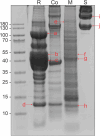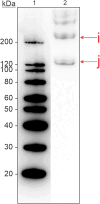Tissue-based skin prick test extracts from Atlantic salmon containing occupationally relevant allergens
- PMID: 40626259
- PMCID: PMC12230974
- DOI: 10.3389/falgy.2025.1525012
Tissue-based skin prick test extracts from Atlantic salmon containing occupationally relevant allergens
Abstract
Introduction: Diagnosis of salmon allergy often includes skin prick testing using commercially available extracts. Multiple studies have shown that these may contain highly variable amounts of important allergens. In this study we aimed to produce skin prick test extracts containing salmon allergens relevant to the occupational exposure situation. The extracts were characterized with respect to the presence of known salmon allergens. The effect of heat-treatment on the antibody-binding of allergens was also assessed.
Method: Allergenic proteins were extracted from muscle, skin, and outer mucus coating from Atlantic salmon (Salmo salar). Electrophoresis was used for protein separation with subsequent silver staining and immunoblotting for the detection of known allergenic proteins with antibody-binding activity to commercially available antibodies. The identity of allergens was confirmed by mass spectrometry.
Results: Our extraction methods were successful in detecting the allergenic proteins aldolase, collagen, enolase, and parvalbumin from muscle, skin, and outer mucus coating from Atlantic salmon. Our work also demonstrates that these allergens have various tolerance towards heating.
Conclusion: By using multiple fish tissues for extraction, we were able to produce skin prick test extracts containing allergens of presumed relevance in diagnosis of work-related sensitization.
Keywords: allergen extracts; occupational allergy; salmon allergy; salmon processing; skin prick testing; thermolabile allergen.
© 2025 Elda, Grgic, Stensvåg and Bang.
Conflict of interest statement
The authors declare that the research was conducted in the absence of any commercial or financial relationships that could be construed as a potential conflict of interest.
Figures




Similar articles
-
Specific allergen immunotherapy for the treatment of atopic eczema.Cochrane Database Syst Rev. 2016 Feb 12;2(2):CD008774. doi: 10.1002/14651858.CD008774.pub2. Cochrane Database Syst Rev. 2016. PMID: 26871981 Free PMC article.
-
ImmunoCAP® ISAC and Microtest for multiplex allergen testing in people with difficult to manage allergic disease: a systematic review and cost analysis.Health Technol Assess. 2016 Sep;20(67):1-178. doi: 10.3310/hta20670. Health Technol Assess. 2016. PMID: 27623692 Free PMC article.
-
Skin care interventions in infants for preventing eczema and food allergy.Cochrane Database Syst Rev. 2022 Nov 14;11(11):CD013534. doi: 10.1002/14651858.CD013534.pub3. Cochrane Database Syst Rev. 2022. PMID: 36373988 Free PMC article.
-
Systemic pharmacological treatments for chronic plaque psoriasis: a network meta-analysis.Cochrane Database Syst Rev. 2021 Apr 19;4(4):CD011535. doi: 10.1002/14651858.CD011535.pub4. Cochrane Database Syst Rev. 2021. Update in: Cochrane Database Syst Rev. 2022 May 23;5:CD011535. doi: 10.1002/14651858.CD011535.pub5. PMID: 33871055 Free PMC article. Updated.
-
Allergen-specific oral immunotherapy for peanut allergy.Cochrane Database Syst Rev. 2012 Sep 12;2012(9):CD009014. doi: 10.1002/14651858.CD009014.pub2. Cochrane Database Syst Rev. 2012. PMID: 22972130 Free PMC article.
References
-
- FAO. The State of World Fisheries and Aquaculture 2022. Towards Blue Transformation. Rome: FAO; (2022). 10.4060/cc0461en - DOI
LinkOut - more resources
Full Text Sources

